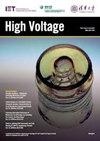基于空心光子晶体光纤的光热光谱C2H2气体传感器的仿真
IF 4.4
2区 工程技术
Q1 ENGINEERING, ELECTRICAL & ELECTRONIC
引用次数: 0
摘要
故障特征气体分析是电力设备运行状态监测的重要手段之一。本文建立了基于空心光子晶体光纤(HC-PCF)的光热光谱气体探测系统的仿真模型。研究了探测光束的相位变化与乙炔浓度、泵浦功率、环境温度和调制频率的关系。它是通过模拟泵浦光束的波长调制和探测光束的相位变化来实现的。结果表明,泵浦功率与探测光束的相位变化幅度和乙炔浓度之间存在线性正相关关系。例如,乙炔浓度从1 ppm增加到10,000 ppm,相变幅度从4.71 × 10−4 rad增加到3.70 rad,泵浦功率从7 mW增加到2000 mW,相变幅度从3.73 × 10−4 rad增加到1.01 × 10−1 rad。探针束的相变与环境温度呈非线性负相关。环境温度从373.15 K降低到173.15 K,相变幅度从5.05 × 10−3 rad增加到2.15 × 10−2 rad,增加了4.26倍。需要调制频率来平衡HC-PCF中的热传导过程。在1-100 Hz范围内,相位变化的幅度是稳定的,几乎与调制频率无关。在100 ~ 40000 Hz范围内,随着调制频率的增加,相变幅度迅速减小。研究结果可为构建基于hc - pcf的光热光谱气体检测系统提供参考。本文章由计算机程序翻译,如有差异,请以英文原文为准。
Simulation of Hollow-Core Photonic Crystal Fibre-Based Photothermal Spectral C2H2 Gas Sensor
Fault characteristic gas analysis is one of the important methods for monitoring the operating status of power equipment. This study presents the construction of a simulation model for a hollow-core photonic crystal fibre (HC-PCF)-based photothermal spectroscopy gas detection system. The relationship between the phase change of the probe beam and the acetylene concentration, pump power, ambient temperature and the modulation frequency is examined. It is achieved by simulating the wavelength modulation of the pump beam and the phase change of the probe beam. The findings demonstrate that there is a linear positive correlation between the pump power and the amplitude of the phase change of the probe beam and the acetylene concentration. For example, acetylene concentration grew from 1 to 10,000 ppm, whereas phase change amplitude increased from 4.71 × 10−4 to 3.70 rad. The pump power grew from 7 to 2000 mW, whereas phase change amplitude increased from 3.73 × 10−4 to 1.01 × 10−1 rad. The phase change of the probe beam is non-linearly and negatively correlated with the ambient temperature. The ambient temperature decreases from 373.15 to 173.15 K, and phase change amplitude increases from 5.05 × 10−3 to 2.15 × 10−2 rad, an enhancement of 4.26 times. The modulation frequency is needed to balance the thermal conduction process in the HC-PCF. In the 1–100 Hz range, the amplitude of the phase change is stable and almost independent of the modulation frequency. In the 100–40,000 Hz range, the amplitude of the phase change decreases rapidly with the increase of the modulation frequency. The results of the paper provide a reference for constructing the HC-PCF-based photothermal spectroscopy gas detection system.
求助全文
通过发布文献求助,成功后即可免费获取论文全文。
去求助
来源期刊

High Voltage
Energy-Energy Engineering and Power Technology
CiteScore
9.60
自引率
27.30%
发文量
97
审稿时长
21 weeks
期刊介绍:
High Voltage aims to attract original research papers and review articles. The scope covers high-voltage power engineering and high voltage applications, including experimental, computational (including simulation and modelling) and theoretical studies, which include:
Electrical Insulation
● Outdoor, indoor, solid, liquid and gas insulation
● Transient voltages and overvoltage protection
● Nano-dielectrics and new insulation materials
● Condition monitoring and maintenance
Discharge and plasmas, pulsed power
● Electrical discharge, plasma generation and applications
● Interactions of plasma with surfaces
● Pulsed power science and technology
High-field effects
● Computation, measurements of Intensive Electromagnetic Field
● Electromagnetic compatibility
● Biomedical effects
● Environmental effects and protection
High Voltage Engineering
● Design problems, testing and measuring techniques
● Equipment development and asset management
● Smart Grid, live line working
● AC/DC power electronics
● UHV power transmission
Special Issues. Call for papers:
Interface Charging Phenomena for Dielectric Materials - https://digital-library.theiet.org/files/HVE_CFP_ICP.pdf
Emerging Materials For High Voltage Applications - https://digital-library.theiet.org/files/HVE_CFP_EMHVA.pdf
 求助内容:
求助内容: 应助结果提醒方式:
应助结果提醒方式:


